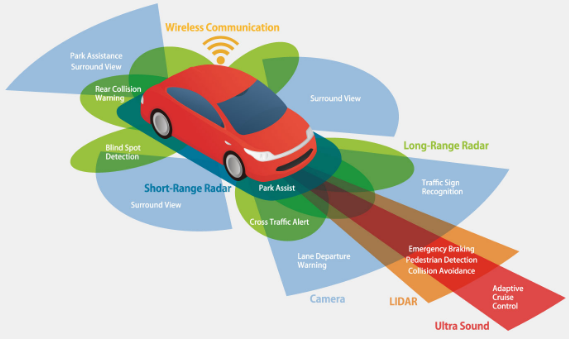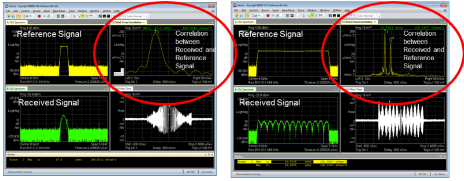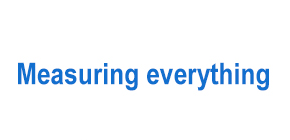News
Millimeter Wave Automotive Radar Seeks to Improve Driver Safety
Automotive radar is the most reliable technology at detecting objects, including velocity and angle in almost every condition. The radar technology has been proven over decades in many industries such as aviation, air traffic control, maritime transport, law enforcement, and of course automotive.
Every year, 1.25 million people are killed by car accidents, and human errors (drunk driving, speeding, ignoring traffic signals, and texting while driving) are responsible for more than 94 percent of these fatal accidents.

Figure 1
To reduce the number of car accidents to as close to zero as possible, car makers, automotive suppliers, governments, academics, and even non-automotive technology providers are jointly developing advanced driver-assistance systems (ADAS) and ultimately autonomous vehicles.
However, traditional 24 GHz narrow-band automotive radar has limited capability to differentiate objects and separate humans, animals, other cars, or even mailboxes. Current mass-market applications of ADAS by automotive radar sensing technology include auto-emergency braking systems, forward collision warning, blind spot detection, lane change assist, rear collision warning systems, adaptive high-speed cruise control on highways.
Wider Bandwidth Automotive Radar
Automotive radar sensing technology, mainstreamed by the 24 GHz narrow band sensors, is now rapidly evolving toward high frequency 76-81 GHz band and wide 5 GHz bandwidth, millimeter wave.
While the 76 GHz is used for long-range detection, the 77-81 GHz band is used for short-range, higher-precision detection.
The error in distance measurement and minimum resolvable distance are inversely proportional to the bandwidth. Transitioning from 24 GHz to 79 GHz delivers 20x better performance in range resolution and accuracy. For instance, the improvement in range resolution from the 75 cm of a 24 GHz system to the 4 cm of a 79 GHz system offers better detection of multiple objects that are close together (Figure 1).
Also with smaller wavelength, the resolution and accuracy of velocity measurement increases proportionally. Therefore, by transitioning from 24 GHz to 79 GHz, velocity measurements can be improved by a factor of 3x.
Another advantage of the transition from legacy 24 GHz to 79 GHz systems is the gain in size and weight. With the wavelength of 79 GHz signals being a third of a 24 GHz system, the total area of a 79 GHz antenna is one-ninth of a similar 24 GHz antenna. Developers can use smaller and lighter sensors and hide them more easily for better fuel economy and car designs.

Figure 2
Test comparisons between 1 GHz and 4 GHz bandwidths (Figure 2) clearly show that only the higher bandwidth solution can measure two different objects, as close as 10 cm apart. The lower bandwidth radar is not able to detect two different objects and provides incorrect data to the driver or autonomous driving system, leading to the wrong decision. If a man and his dog are walking closely together and the dog suddenly jumps onto the road, only the wider bandwidth radar (test on right) can detect both separately and provide the correct information to the driver or the autonomous driving system. On the other hand, the narrower bandwidth radar (test on left) provides wrong or confusing information, possibly leading to a tragic accident.

Figure 3
Radar the Clear Solution
Automotive radar is today’s leading sensing technology for increasing driving safety in all environmental conditions. Advanced automotive radar takes advantage of 76-81 GHz band higher frequency and 5 GHz wider bandwidth for better resolutions, smaller and lighter sensor design, applicable to current and future ADAS, and upcoming autonomous driving systems.
To bring about an ideal world of zero-fatal car accidents, automotive radar developers need to optimize their design and test methods, and prove the reliability and safety of their solutions.
Source: RSI
Others
- TECOTEC GROUP ATTENDED SHIMADZU’S SERVICE MANAGER MEETING IN 2022
- TECOTEC HANDED OVER EDX-7000 X-RAY FLOURESCENCE SPECTROMETER AT NIDEC CHAUN CHOUNG VIETNAM
- INSTALLATION OF CHIP PROCESSING SYSTEM – LANNER/ GERMANY
- TECOTEC completed installation of EDX-LE Energy dispersive X-ray Fluorescence spectrometer at DYT Vina
- TECOTEC DELIVERED AND INSTALLED THE 2ND X-RAY FLUORESCENCE SPECTROMETER - EDX-LE PLUS AT TABUCHI
- TECOTEC Group has handed over PDA-7000 Optical Emissions Spectrometers for Nihon Plast Vietnam
- Bowman XRF Coating Measurement System For Electroless Nickel Plating
- TECOTEC DELIVERED AND INSTALLED SMX-2000 SYSTEM TO NIDEC TECHNO MOTOR VIETNAM



